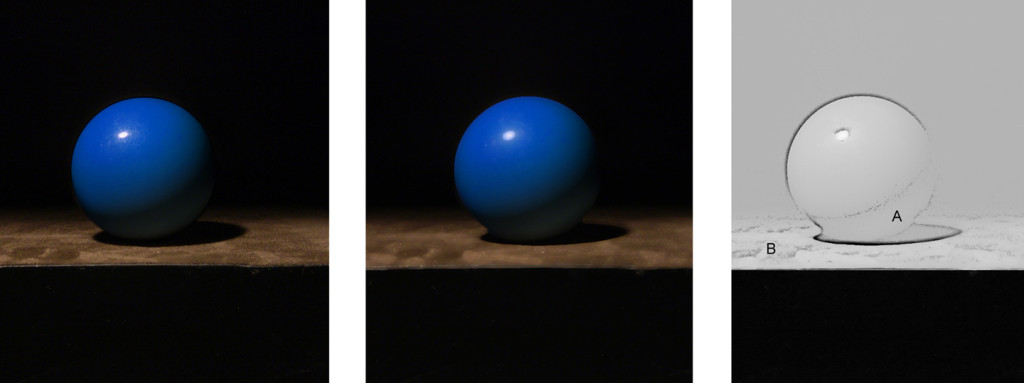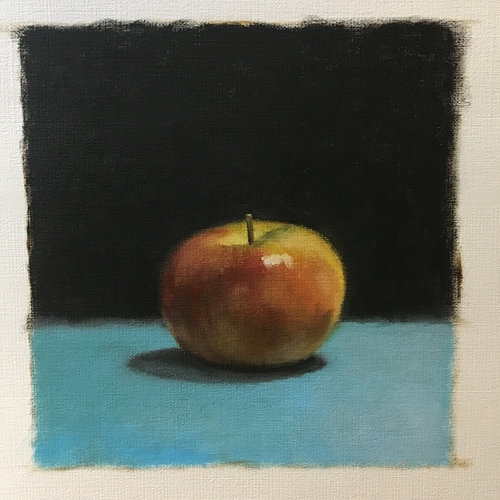Wonderful job!!!
As to dynamic squinting—here is an excerpt from an article I wrote about the practice a few years ago. I think it will help to clarify its use:
Squint. Squinting, the third layer of this analysis, is one of the most useful tools for visual information gathering in an observational/representational art context. When we squint, we alter the shape of the eye’s lens and reduce the amount of light that can enter the eye. As such, our visual acuity is decreased proportionally to the severity of the squint. Lightness levels decrease as numerous value steps merge together into larger, fuzzy chunks of light and dark. This simplification allows for the artist to capture larger (macro) components that may not be as apparent amidst complexity, when visual acuity is high. (It is also worth noting that the perceived intensity of colors is diminished here with the decrease of incoming light.)
If I suspect that there may be an issue with micro-macro value pattern relationships, I will revisit the earlier mentioned scan phase but with a strong, fixed squint. If the overall patterns look reasonably accurate, I will proceed to specific value relationship comparison with a dynamic squint . The dynamic squint is a way of using the mechanics of our perception to analyze relative value relationships when quantitative measurements (like that of a light meter or spectrophotometer) are not available. Here is how it works:

The blue sphere on the left represents the artist’s reference source while the central image represents the artist’s painting or drawing. The central illustration demonstrates a reflected light (A) that is recorded too light.
The image on the left represents the artist’s reference source while the image in the middle represents an artist’s drawing or painting effort. The far right image is a legend illustrating which areas we are discussing. Let’s assume that the basic anchor values were established aligning the darkest darks and lightest lights with the limitation of the available materials. Subsequent values were added by judging against these initial anchors in an effort to build corresponding value relationships–but now we need to check those judgements. This is where the dynamic squint comes in.
To make this example simple, let’s limit our focus to analyzing two target values with a dynamic squint: The reflected light on the sphere (A) and the overall value of the sphere’s resting surface (B).
I begin by targeting specific value relationships for analysis. Value relationships that I will choose to start with are those that have ‘popped out’ in the earlier scan and stereo phase. For now, let’s begin with the reflected light (A) on the sphere. I begin by fixing the target reference area/value in my gaze and slowly increase the severity of my squint until the values that represent the reflected light are “merged” into the surrounding analogous values. With my squint halted and maintained right at the specific severity level to achieve this merging, I turn my gaze to the corresponding area on the drawing. If the corresponding target value on the drawing or painting is still noticeable at the “squint severity” that caused the reference target area value to merge with analogous surrounds, then I know that the value relationship in that area is not representing the reference target relationships accurately. In this case it would mean that the reflected light is most likely too light in this context.

The blue sphere on the left represents the artist’s reference source while the central image represents the artist’s painting or drawing. The central illustration demonstrates a reflected light (A) that is recorded too dark.
To see if I may be too dark I will reverse the process and begin with a gaze at the drawing and squint until the target value merges with surrounding analogous values. When this happens, just like before, the squint is arrested and the gaze shifted to the reference target. If the corresponding target reference value is liberated from the surround then I know that my drawn or painted value is too dark.
Let me know if this helps Sigrid! 
 gives a real idea of the miniaturisation of the overall process. My first day working from home today (been doing 16+ hour shifts dealing with tricky computer stuff lately, so no art has happened for a while.) but today I got to sneak in a master copy while I followed along with your video:-
gives a real idea of the miniaturisation of the overall process. My first day working from home today (been doing 16+ hour shifts dealing with tricky computer stuff lately, so no art has happened for a while.) but today I got to sneak in a master copy while I followed along with your video:- 




 are you squinting real hard at the subject and then turning to face the painting to see you’re seeing the same thing?
are you squinting real hard at the subject and then turning to face the painting to see you’re seeing the same thing?




 or a full-on double-eye squint like this
or a full-on double-eye squint like this  or should i look like i’m in pain:
or should i look like i’m in pain:  ?
?


